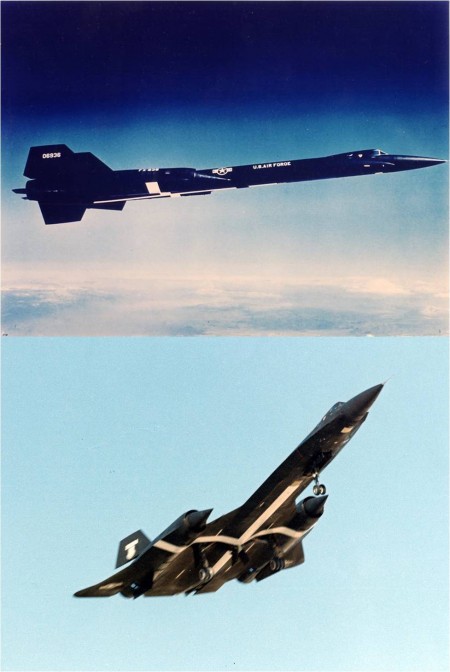Forty-eight years ago this month, the USAF/Lockheed YF-12A set a bevy of world speed and altitude peformance records. A pair of aircraft and a team of five USAF aircrew flew these missions which originated out of Edwards Air Force Base, California.
The YF-12A was the interceptor variant of the vaunted Lockheed A-12 Mach 3+ aircraft. Armed with a quartet of Hughes AIM-47A air-to-air missiles, the YF-12A’s mission would be to intercept and destroy incoming Soviet bombers. Lockheed proposed the A-12 variant as a cost-effective replacement for the defunct North American XF-108 Rapier.
The YF-12A differed from the A-12 in that a second crew station was added for the AIM-47A Weapons Systems Officer (WSO). The WSO operated the powerful Hughes AN/ASG-18 fire control radar which had a range on the order of 500 miles. The YF-12A’s forebody chines were truncated back of the axisymmetric nose to accommodate the radar system. Infrared (IR) sensors were installed on the leading edges of the shortened chines.
The Hughes AIM-47A missile measured 12.5 feet in length and 13.5 inches in diameter. Maximum range of the 800-pound missile was in excess of 100 miles. While the type’s intended maximum Mach number was 6, propulsion system development problems limited the demonstrated maximum Mach number to 4. About eighty (80) AIM-47A missiles were produced. Seven (7) of these rounds were test fired in flight. All but one (1) was successful.
Lockheed converted a trio of A-12 aircraft to the YF-12A configuration. The YF-12A aircraft were assigned serial numbers 60-6934 (Ship 1), 60-6935 (Ship 2) and 60-6936 (Ship 3). Ship 1 made the maiden YF-12A flight from Groom Lake, Nevada on Wednesday, 07 August 1963 with James D. Eastham at the controls.
On Saturday, 01 May 1965, YF-12A aircraft 60-6934 and 60-6936 were flown by a quintet of USAF aircrew in an impressive demonstration of the interceptor’s altitude and speed performance. These missions were conducted by the Air Force Flight Test Center (AFFTC) at Edwards Air Force Base, California. Specifically, the following FAI-certified Class C Group III absolute performance records were established on that day:
Sustained Altitude (Absolute): 80,258 feet
Aircraft: YF-12A, Ship 1 (Serial Number 60-6934)
Aircrew: Col Robert L. Stephens/Lt Col Daniel Andre
15/25 km Closed-Circuit (Absolute): 2,070.102 mph
Aircraft: YF-12A, Ship 3 (Serial Number 60-6936)
Aircrew: Col Robert L. Stephens/Lt Col Daniel Andre
500 km Closed-Circuit (Class C): 1,643.042 mph
Aircraft: YF-12A, Ship 3 (Serial Number 60-6936)
Aircrew: Maj Walter F. Daniel/Maj Noel T. Warner
1,000 km Closed-Circuit, No Payload: 1,688.891 mph
Aircraft: YF-12A, Ship 3 (Serial Number 60-6936)
Aircrew: Maj Walter F. Daniel/Capt James P. Cooney
1,000 km Closed-Circuit, 1,000 kg Load (Absolute): 1,688.891 mph
Aircraft: YF-12A, Ship 3 (Serial Number 60-6936)
Aircrew: Maj Walter F. Daniel/Capt James P. Cooney
1,000 km Closed-Circuit, 2,000 kg Load (Class C): 1,688.891 mph
Aircraft: YF-12A, Ship 3 (Serial Number 60-6936)
Aircrew: Maj Walter F. Daniel/Capt James P. Cooney
USAF liked the YF-12A’s demonstrated performance capabilities. Thus, on Friday, 14 May 1965, the service ordered ninety-three (93) units of the production YF-12A aircraft known as the F-12B. Congress approved the order and allotted $90M to get production going. Unfortunately, United States Secretary of Defense Robert S. McNamara nixed the deal and cancelled the production of the F-12B.
Following the F-12B cancellation, YF-12A flight testing by USAF continued through 1969. One aircraft was lost along the way. On Thursday, 14 August 1966, Ship 1 was severely damaged in a landing incident at Edwards AFB and never flew again. Fortunately, the crew escaped with their lives.
In December of 1969, NASA initiated a flight research effort using YF-12A Ship 2 and Ship 3. Over the next ten (10) years a wealth of aerodynamic, aero heating, structural and propulsion flight research data were acquired using these unique high-speed assets. A great benefit in this regard was the type’s ability to sustain Mach 3+ flight conditions for periods up to 15 minutes per mission.
YF-12A Ship 3 was lost on Thursday, 24 June 1971 when an inflight fire started due to a failed fuel line in the right-hand J58 turbo-ramjet engine. The USAF crew of pilot Lt Col Ronald J. Layton and WSO Maj William A. Curtis attempted to recover the aircraft to Edwards AFB. However, the fire quickly spread and forced the crew to abandon the aircraft. They ejected safely and survived. Ship 3 was making its 67th flight of the NASA YF-12A flight research effort at the time of its demise.
Following Ship 3′s loss, Ship 2 flew the remainder of the NASA YF-12A high-speed flight research program. It registered a total of 146 missions in that capacity. On Wednesday, 07 November 1979, YF-12A Ship 2 departed Edwards AFB for its final destination; the USAF Musuem at Wright-Patterson AFB, Ohio. The USAF crew consisted of pilot Col James V. Sullivan and USAF Museum Director Richard Uppstrom as the guy in back (GIB).
The only YF-12A aircraft to survive the USAF and NASA flight programs was Ship 2. That aircraft (60-6935) is currently on display in the Research and Development Gallery at the United States Air Force National Museum in Dayton, Ohio. Also displayed there is the 1965 Thompson Trophy that was awarded to Col Robert L. Stephens and Lt Col Daniel Andre for their record-setting YF-12A flight of 2,070.102 mph.



Comments
I’m thoroughly enjoying you history posts.
The YF-12A was an incredible machine. I remember when I first learned about it, reading my uncle’s Popular Mechanics (or maybe Popular Science) magazines way back when.
Next year, you can post about X-51A on 1 May!
Share this post:
Hello Glenn! Glad you are enjoying our aerospace history posts. It is nice to know as well that you are part of our readership. I look forward to May 2014 when we can honor the achievements of X-51A Flight No. 4. Congratulations to you and everyone on the X-51A Team for a great accomplishment!
Share this post: